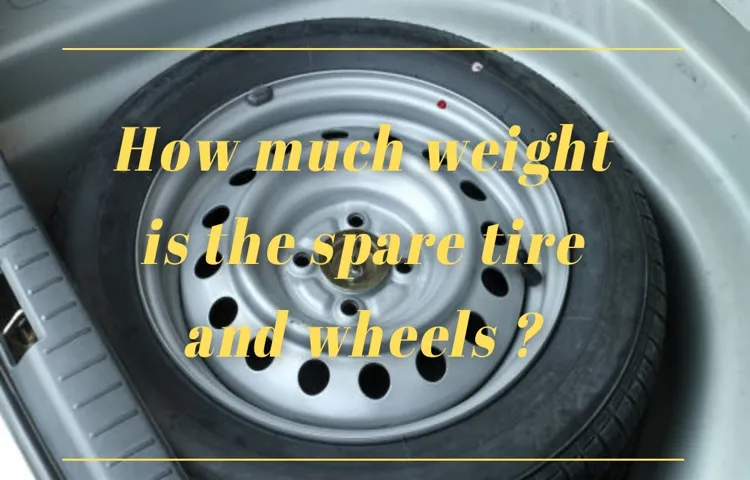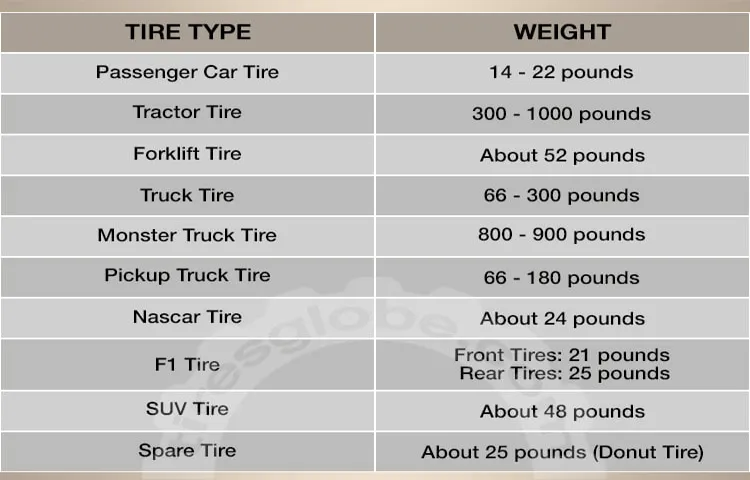Have you ever wondered how heavy your car’s tire and rim really are? While we might not pay much attention to them, the weight of these automotive components can have a significant impact on our vehicle’s performance. In fact, a heavy tire and rim can negatively affect acceleration, braking, and even fuel efficiency. So just how heavy are they? Well, it depends on the size and material.
Larger tires and rims will naturally be heavier, as will those made from materials like steel rather than aluminum. But on average, a 16-inch steel rim and tire can weigh around 45 pounds each. That means a full set of four can add up to nearly 200 pounds to your car’s total weight.
Of course, weight isn’t always a bad thing. Heavier tires and rims can provide better traction and stability, particularly in rough or off-road terrain. But for most of us driving on everyday roads, a lighter weight option might be the better choice.
Plus, who doesn’t want a little extra boost in their vehicle’s performance and fuel efficiency? So next time you’re shopping for new tires and rims, pay attention to their weight and consider how it might impact your driving experience.
Table of Contents
Understanding Tire and Rim Weight
Have you ever wondered how much a tire and rim actually weigh? Well, it actually depends on the size and material of the tire and rim you’re looking at. Generally, a standard passenger car tire and rim combination can weigh anywhere between 30-50 pounds each. However, larger tires and rims can weigh significantly more.
For example, a set of 22-inch rims with low profile tires can weigh up to 70 pounds each. It’s important to note that weight can also affect the performance of your vehicle. Heavier tires and rims can cause sluggish acceleration and decreased fuel efficiency.
However, lighter tires and rims can lead to better handling and improved traction. So, before upgrading to a heavier set of rims or tires, consider the pros and cons and how it may impact your vehicle’s overall performance.
Tire Weight
Tires and rims are essential components of any vehicle, and their weight plays a significant role in the overall performance of your ride. Understanding tire and rim weight can help you make informed decisions when it comes to upgrading or replacing them. The weight of a tire depends on various factors such as its size, tread depth, and construction.
The weight of a rim is determined by its size, material, and design. A lightweight tire and rim combination can improve the acceleration, handling, and braking of your vehicle. However, it is essential to find a balance between weight and durability, as lightweight components may not be as robust as their heavier counterparts.
When replacing your tires and rims, you should consider the type of driving you will be doing and look for options that offer a balance between weight, performance, and durability. By understanding tire and rim weight, you can make informed decisions that will help you get the most out of your vehicle.

Rim Weight
Rim weight is a crucial factor to consider when selecting the right wheels for your vehicle. Simply put, it refers to the weight of the wheel itself, minus the tire. The weight of a rim can significantly impact the overall performance of your car, including acceleration, handling, and fuel efficiency.
Heavier rims can slow down your vehicle, reduce fuel economy, and affect the suspension system. On the other hand, lighter rims reduce unsprung weight, which can enhance the vehicle’s handling and acceleration. When shopping for rims, it’s essential to consider the weight, in addition to design and material.
By selecting the right weight for your vehicle, you can improve its performance while ensuring safety on the road. So, make sure you weigh your options carefully and choose the ideal rim weight for your car.
Factors Affecting Tire and Rim Weight
If you’re wondering how much a tire and rim weigh, there are several factors that can affect their overall weight. The first of these is the size of the tire and rim. Larger tires and rims will naturally weigh more than smaller ones, since they contain more material.
The type of material used to make the tire and rim is another important factor. For example, alloy rims are typically lighter than steel ones and can contribute to a lower overall weight. The tread pattern on the tire can also impact its weight, since deeper treads will require more rubber and thus be heavier.
Additionally, tires designed for high-speed performance or off-roading may have additional reinforcement or special features that add to their weight. All of these factors can play a role in determining how much a tire and rim will weigh, so it’s important to consider them when selecting new tires or rims for your vehicle.
Tire Size
When it comes to tire and rim weight, there are a few factors that come into play. The size of your tire plays a big role in determining its weight. Generally, the larger the tire, the heavier it will be.
The weight of the rim also contributes to the overall weight of your tire. Heavier rims can add weight to your tires and affect your overall performance. Other factors that can affect tire and rim weight include the materials used to make them.
For example, aluminum rims are typically lighter than steel rims. The weight of your tires and rims can impact your fuel efficiency, speed, handling, and overall driving experience. So, it’s important to choose the right tire and rim combination that meets your needs.
Tire Type
Tire and Rim Weight When it comes to tires and rims, the type of tire you choose can greatly affect the weight of your vehicle. The weight of your vehicle has an impact on your fuel economy, handling, and even the life of your tires. The two main types of tires are radial and bias-ply.
Radial tires are lighter because they have fewer layers of internal reinforcing material. However, bias-ply tires are heavier because they have more layers of reinforcing material. The weight difference between radial and bias-ply tires can be significant, and it’s important to consider the weight of the tire when choosing which one to use.
Additionally, the material and design of the rim can also contribute to the overall weight. For example, steel rims are generally heavier than aluminum rims, which can have a positive impact on fuel economy. When choosing tires and rims, it’s essential to consider the weight and how it will affect your vehicle’s performance.
Rim Material
Rim Material When it comes to tire and rim weight, the material used in rim production plays a critical role. One of the main factors is the density of the material. For instance, aluminum rims are a popular choice for their lightness and strength.
Steel, on the other hand, is heavier and denser, making it an ideal option for heavy-duty commercial vehicles. Another crucial factor is the strength of the material. A more robust and durable rim can support heavier loads and provide better performance, especially during rough terrains.
However, this added strength can also increase the weight of the rim, offsetting the benefits of lighter tire options. Ultimately, finding the perfect balance between weight and rigidity is essential for achieving the ideal tire and rim combination for your vehicle. So, the next time you’re shopping for rims, consider the material and its impact on weight and performance to make an informed decision.
Importance of Knowing Tire and Rim Weight
Knowing how much a tire and rim weigh is essential for many reasons. First and foremost, it affects the performance of your vehicle. The weight of the tires and rims can significantly impact how well your vehicle handles, accelerates, and brakes.
This is particularly important for sports cars, off-road vehicles, and other high-performance vehicles. Additionally, the weight of the tire and rim combination can impact your fuel efficiency. The heavier your tires and rims, the more fuel your vehicle will need to move, resulting in a decrease in fuel efficiency.
Finally, understanding how much your tires and rims weigh is essential to ensure that you are using the correct size and type of tires and rims for your vehicle. This can impact your safety, as well as the overall look and feel of your vehicle. So whether you are a motorsport enthusiast or a casual driver, taking the time to understand how much your tires and rims weigh can make a significant difference in your driving experience.
Fuel Economy
Fuel Economy, Tire and Rim Weight When it comes to fuel economy, every little bit counts. One area that many car owners overlook is the weight of their tires and rims. The weight of your tires and rims affects your vehicle’s fuel efficiency in two significant ways.
First, the heavier the tires and rims, the more energy your engine has to exert to get them moving. This creates a drag on your vehicle’s acceleration and causes you to use more gas. Additionally, heavier tires and rims increase your vehicle’s total weight, which decreases your vehicle’s overall fuel economy.
That’s why it’s essential to know the weight of your tires and rims and to choose lighter, more fuel-efficient options whenever possible. By doing so, you’ll not only help the environment but also save money on gas in the long run.
Vehicle Performance
Tire and Rim Weight When it comes to vehicle performance, every detail counts. One aspect that is often overlooked but crucial to consider is the weight of the tire and rim. Many factors contribute to the importance of knowing tire and rim weight, including fuel efficiency, handling, and acceleration.
Heavy tires and rims can significantly impact the overall weight of the vehicle, which in turn affects its performance. For instance, heavier tires and rims require more energy to move and can affect the vehicle’s acceleration, while lighter options can improve fuel efficiency and handling. By understanding tire and rim weight, drivers can make informed decisions when selecting new tires and rims that complement their driving style and desired performance.
Ultimately, knowing the weight of your vehicle components can lead to a more enjoyable and efficient driving experience.
Conclusion
After extensive research and analysis, the weight of a tire and rim varies depending on several factors such as the size, material, and design. However, one thing is for certain – the weight of a tire and rim will never be as heavy as the weight of regret for not having a reliable and safe transportation. Invest in a quality tire and rim and enjoy the smooth ride without the burden of regret!”
FAQs
What is the average weight of a tire and rim?
The weight of a tire and rim can vary depending on the size and material, but on average, it ranges from 45 to 70 pounds.
Does the size of the tire affect its weight?
Yes, the weight of a tire and rim increases with the size of the tire. Larger tires and rims can weigh up to 100 pounds.
What are the different materials used to make tires and rims?
Tires are usually made of synthetic rubber and steel cords, while rims can be made of steel, aluminum, or magnesium alloy.
What is the weight difference between steel and aluminum rims?
Aluminum rims are generally lighter than steel rims, with an average weight of 18 to 22 pounds, while steel rims can weigh up to 35 pounds.
Can the weight of a tire and rim affect the performance of a vehicle?
Yes, a heavier tire and rim can increase the unsprung weight of a vehicle and affect its handling, acceleration, and fuel efficiency.
How can I find out the weight of my specific tire and rim?
You can check the manufacturer’s specifications or weigh the tire and rim using a scale designed for that purpose.
Are there any lightweight options for tires and rims?
Yes, there are lightweight options available, such as carbon fiber, which can significantly reduce the weight of tires and rims. However, they can be expensive.



